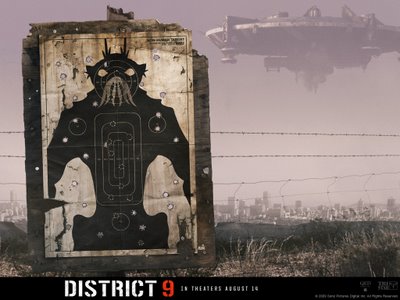District 9 opened this weekend, and wow, is it terrific: both gripping and totally thrilling, a thoughtful and intelligent movie chock-full of death rays, mecha battles, and mother ships. It’s also a rare wide-release movie set in a cultural context wildly different from America or Europe. So, as the tor.com blogger with (I believe) the most direct experience of South Africa, I thought I’d explain a few of the cultural references that might be mysterious to you:
District Six. A famous ghetto in Cape Town, always South Africa’s most liberal city, in which people of all races coexisted harmoniously even during the apartheid years. In the 1970s, more than 60,000 people were forcibly removed from the district and resettled elsewhere, on the grounds that interracial interaction bred conflict. Cape Town’s District Six Museum maintains a memorial to that shattered community, and the title of District 9 is almost certainly a nod to District Six.
Johannesburg. At one point, the protagonist of District 9 flees through the grass-covered hills that surround this skyscraper-studded megalopolis of 10 million: they’re manmade, the heaped tailings of 19th century gold mining. Some 40% of all the gold ever mined from the Earth came from beneath Johannesburg. To this day, at the Gold Reef City amusement park just south of the city center, you too can plummet half a mile into the earth to tour an ancient gold mine.
Muti. Black magic, the belief in which is pervasive throughout sub-Saharan Africa, and often deadly. I have seen local newspapers in Zimbabwe report the terrifying discoveries of goblins or tokoloshes without irony. See Ryszard Kapuscinski’s The Shadow of the Sun, the best book ever written about Africa, for more about muti, among many other things.
Nigerians. South Africa is a remarkably xenophobic society. Because it is Africa’s economic superpower, immigrants flock to it from across the continent, especially from Zimbabwe, a once-prosperous neighbor ruined by a despotic leader, and Nigeria, Africa’s most populous country. But illegal immigrants, particularly Nigerians, are scapegoated for the country’s high crime rate and for taking jobs away from South African citizens. (Sound familiar?) District 9 is partly metaphor for the apartheid years, yes, but also for the xenophobia of present-day South Africa, and I for one was pleased to see that both the movie’s text and subtext feature as one of their major morals: you do not want to fuck with the Nigerians. I was less pleased to see the Nigerian English subtitled.
Prawn. Means shrimp in British-influenced English.
Race. All I want to say about race in South Africa today is that the subject is very, very complicated—this is a country with eleven official languages, and scores of unofficial ones—and any attempt to superimpose American or European norms on the subject should probably be reconsidered before it even begins. That said, the incursion into the alien township, and the way the aliens are treated, are clearly meant to recall the terrible apartheid years.
Townships. South African cities built during apartheid invariably feature a white-dominated downtown surrounded by satellite townships where the black workers lived, with barren no-man’s-lands between. (Soweto, the most famous, is only one of many around Johannesburg; the name comes from Southwest Township.) The apartheid government built them to be governed and controlled with an iron fist: for instance, Khayelitsha, Cape Town’s largest suburb, is speckled with 200-foot-tall floodlights that could turn night into day so that troops could search the area. The razor-wired alien township in District 9 is little poorer, or more neglected, than the worst townships in South Africa today.
Violence. South Africa is much less violent than most Westerners (and, indeed, most white South Africans) imagine. Johannesburg does have no-go areas such as Hillside, but most of it is perfectly safe by day, and I’ve wandered Cape Town by night without ever setting off my street-smarts alarm. However, it does remain a volatile society, and private security forces such as those in District 9 are ubiquitous.
For more. I recommend the hugely entertaining books Acid Alex, an autobiography by Al Lovejoy, a Zimbabwean/South African reform-school-dropout-turned-drug-dealer-who-found-God, and everything by Jonny Steinberg, particularly The Number, about South Africa’s jails and the truly extraordinary gang mythology found therein.
Jon Evans is the author of several international thrillers, including Dark Places and Invisible Armies, and the forthcoming Vertigo graphic novel The Executor. He also occasionally pretends to be a swashbuckling international journalist. His novel Beasts of New York, an epic fantasy about a squirrel in Central Park, is freely available online, under a Creative Commons license.










